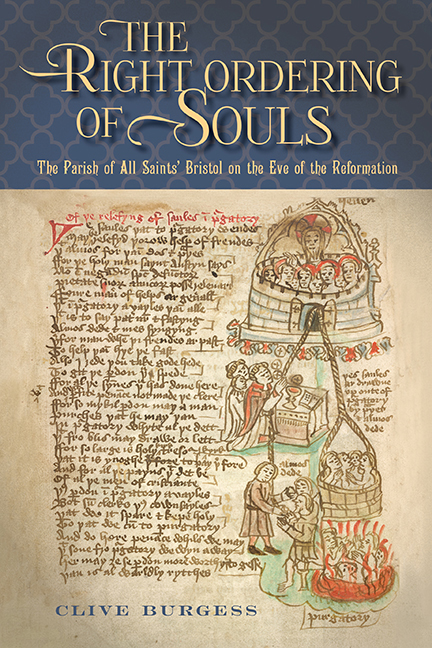Book contents
- Frontmatter
- Dedication
- Contents
- List of illustrations
- Acknowledgements
- Miscellaneous Frontmatter
- Abbreviations
- Notes
- map
- Part I For the increase of the divine service
- Part II All Saints’, Bristol, and its parishioners
- Part III Commemorating the dead
- Part IV Leaders and administrators
- Part V Ordering the parish
- Appendices
- Bibliography
- Glossary
- Index
- Miscellaneous Endmatter
Part V - Ordering the parish
Published online by Cambridge University Press: 05 May 2018
- Frontmatter
- Dedication
- Contents
- List of illustrations
- Acknowledgements
- Miscellaneous Frontmatter
- Abbreviations
- Notes
- map
- Part I For the increase of the divine service
- Part II All Saints’, Bristol, and its parishioners
- Part III Commemorating the dead
- Part IV Leaders and administrators
- Part V Ordering the parish
- Appendices
- Bibliography
- Glossary
- Index
- Miscellaneous Endmatter
Summary
THE desire to embellish their neighbourhood church and to develop its amenities weighed heavy with late medieval parishioners and, among those with means, many responded lavishly. Moreover, parish leaders – usually either identical to, or closely associated with, those who proved so generous – primed and orchestrated schemes involving fellow parishioners in pursuit of collective improvements. A broader swathe participated in these initiatives but, as well as contributing a good proportion of the funds, the elite bestowed invaluable managerial expertise; their commitment, in particular, helped to ensure the success of communal ventures. Fifteenth- and early sixteenth-century parish building campaigns disclose ambitious investment in many English localities, resulting, as noted, in a rich part of our late medieval heritage. Ordinarily we can say little either about the individual largesse or the co-operative endeavours that so enhanced many parish churches, meaning that these buildings stand in silent indictment of our ignorance. By contrast, the All Saints’ archive reveals a good deal about the transformation wrought by parishioners as they refurbished their church, added to staff, and invested in divine service. A clearer understanding of what clergy and laity together accomplished, albeit in a small parish, sheds valuable light on developments elsewhere in the town and also beyond Bristol.
Although primarily concerned with parishioners’ attainments, both in reconfiguring their church and cultivating its liturgy, this section also highlights a number of related themes – and so, for instance, where previous discussion emphasised individual generosity, the role played by co-operative endeavour will now be brought to the fore. Moreover, while the next chapter outlines the improvements that parishioners and the clergy made to the church fabric and its fittings, the one following (chapter 11) explores the rites accommodated within the refurbished building. Liturgy needed a setting: by elaborating on each, these two chapters attempt to integrate this fundamental – but, at this distance in time, all too often obscure – aspect of parish life. Previous sections investigated the manner in which parishioners contributed to the various avenues open to them – either by making benefactions in life and by their wills, or arranging commemorative strategies, or working, whether as clergy, masters or churchwardens, for the greater profit of the community; this section attempts to piece together the developing liturgical corporation that resulted from their activities.
- Type
- Chapter
- Information
- 'The Right Ordering of Souls'The Parish of All Saints’ Bristol on the Eve of the Reformation, pp. 329 - 330Publisher: Boydell & BrewerPrint publication year: 2018

